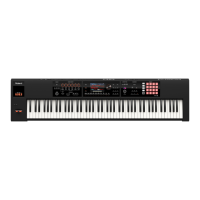PCM Drum Kit (PCMD)
64
Parameter Value Explanation
Pitch Env Level 0-4 -63–+63
Specify the pitch envelope levels (Level 0–Level 4). It determines how much the pitch changes
from the reference pitch (the value set with Coarse Tune or Fine Tune on the Pitch screen) at each
point. Positive (+) value will cause the pitch to be higher than the standard pitch, and negative (-)
value will cause it to be lower.
T1
T: Time L: Level
T2 T3 T4
L3
L4
L2
L1
L0
Note o
Pitch
Time
Note on
TVF tab
Filter Type OFF, LPF, BPF, HPF, PKG, LPF2, LPF3
Selects the type of lter. A lter cuts or boosts a specic frequency region to change a sound’s
brightness, thickness, or other qualities.
OFF: No lter is used.
LPF: Low Pass Filter. This reduces the volume of all frequencies above the cuto frequency (Cuto
Freq) in order to round o, or un-brighten the sound. This is the most common lter used in
synthesizers.
BPF: Band Pass Filter. This leaves only the frequencies in the region of the cuto frequency (Cuto
Frequency), and cuts the rest. This can be useful when creating distinctive sounds.
HPF: High Pass Filter. This cuts the frequencies in the region below the cuto frequency (Cuto
Frequency). This is suitable for creating percussive sounds emphasizing their higher ones.
PKG: Peaking Filter. This emphasizes the frequencies in the region of the cuto frequency (Cuto
Frequency). This can be used to portray the resonance peak of a drum.
LPF2: Low Pass Filter 2. Although frequency components above the Cuto frequency (Cuto
Frequency) are cut, the sensitivity of this lter is half that of the LPF. This makes it a comparatively
warmer low pass lter. This lter is good for use with simulated instrument sounds such as the
acoustic piano.
LPF3: Low Pass Filter 3. Although frequency components above the Cuto frequency (Cuto
Frequency) are cut, the sensitivity of this lter changes according to the Cuto frequency. While
this lter is also good for use with simulated acoustic instrument sounds, the nuance it exhibits
diers from that of the LPF2, even with the same TVF Envelope settings.
NOTE
If you set “LPF2” or “LPF3,” the setting for the Resonance parameter will be ignored.
Cuto Frequency 0–127
Selects the frequency at which the lter begins to have an eect on the waveform’s frequency
components.
With “LPF/LPF2/LPF3” selected for the Filter Type parameter, lower cuto frequency settings
reduce a tone’s upper harmonics for a more rounded, warmer sound. Higher settings make it
sound brighter.
If “BPF” is selected, harmonic components will change depending on the TVF Cuto Frequency
setting. This can be useful when creating distinctive sounds.
With “HPF” selected, higher Cuto Frequency settings will reduce lower harmonics to emphasize
just the brighter components of the sound.
With “PKG” selected, the harmonics to be emphasized will vary depending on Cuto Frequency
setting.
Resonance 0–127
Emphasizes the portion of the sound in the region of the cuto frequency, adding character to the
sound. Excessively high settings can produce oscillation, causing the sound to distort.
LPF BPF HPF PKG
Level
Cuto Frequency
Frequency
parameter value
High
Low

